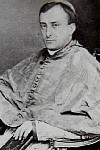

Birth. November 15, 1828, Rome. Son of Charles Lucien Bonaparte (1803-1857), prince of Canino, and Princess Zénaïde Laetitia Julie. His father, Charles Joseph, was the son of Luciano Bonaparte and Zenaïde Bonaparte (1801-1854), daughter of José Bonaparte. He was, therefore, grand-nephew of Emperor Napoléon I, both by father and mother. Baptized by his grand-uncle Cardinal Joseph Fesch (1803). His godfather was his cousin Louis-Napoléon Bonaparte, future emperor Napoléon III.
Education. Entered the ecclesiastical state, March 1854. (No educational information found). Resigned his title of prince of Canino e Musignano.
Priesthood. Ordained, December 13, 1857, Rome, by Pope Pius IX. Vicar in S. Maria in Via Lata, Rome, parish of the Bonaparte palace. Resided in Paris and was named chaplain of Emperor Napoléon III's court. Protonotary apostolic.
Cardinalate. Created cardinal priest in the consistory of March 13, 1868; received the red hat and the title of S. Pudenziana, March 16, 1868. Participated in the First Vatican Council, 1869-1870. Camerlengo of the Sacred College of Cardinals, January 28, 1876 to March 12, 1877. Participated in the conclave of 1878, which elected Pope Leo XIII. Opted for the title of S. Lorenzo in Lucina, September 19, 1879. Cardinal protoprete.
Death. November 19, 1895, at 12:20 p.m., unexpectedly of a syncope, in Rome. Exposed in his title and buried in the tomb of the Primoli family, Campo Verano cemetery, Rome. Later, his remains were transferred to the Basilica of Santa Pudenziana (1).
Bibliography. "Cardinali defunti." La Gerarchia Cattolica e la Famiglia Pontificia per l'anno 1903, Città del Vaticano : Tipografia poliglotta vaticana, 1903, p. 197; Dalla Torre, Paolo. "Luciano, Luigi, Giuseppe, Napoleone Bonaparte." Enciclopedia Cattolica, 12 vols. Città del Vaticano: Ente per l'Enciclopedia Cattolica e per il Libro Cattolico, 1949-1954, vol. II, col. 1834; Ritzler, Remigium, and Pirminum Sefrin. Hierarchia Catholica Medii et Recentioris Aevi. Volumen VIII (1846-1903). Patavii : Typis et Sumptibus Domus Editorialis "Il Messaggero di S. Antonio" apud Basilicam S. Antonii, 1979, pp. 17-18, 49, 52 and 63; Weber, Christoph. Kardinäle und Prälaten in den letzten Jahrzehnten des Kirchenstaates : Elite-Rekrutierung, Karriere-Muster u. soziale Zusammensetzung d. kurialen Führungsschicht zur Zeit Pius' IX. (1846-1878). Stuttgart : Hiersemann, 1978. (Päpste und Papsttum; Bd. 13, I-II), II, 442, 556, 690, 728, 742, 748 and 754.
Webgraphy. His engraving and biography by Colonel Henri Ramé in Le Dictionnaire du Second Empire, Fayard, 1995, in French, Napoléon III; his coat of arms in the church of S. Pudenziana, Rome, romelover.it; engravings, arms photograph and portrait, Araldica Vaticana.
(1) This is the text of the inscripiton on his tomb, kindly provided by Mr. Eman Bonnici, from Malta
LVCIANVS·BONAPARTE
PRESBYTER·CARDINALIS
TITVLI·SANCTAE·PVDENTIANAE
ET·SANCTI·LAVRENTII·IN·LVCINA
OBIIT·XIX·NOVEMBRIS·MDCCCXVC
ANNOS·NATVS·LXVII.
MISERERE·EIVS·DEVS
SECVNDVM·MAGNAM·MISERICORDIAM·TVAM
MARIA·MATER·MISERICORDIӔ
ORA·PRO·EO

Birth. September 14 (1), 1810, Fano. Received the sacrament of confirmation, February 10, 1828.
Education. Studied at the University of Macerata, where he received a doctorate ad honorem of philosophy, on July 20, 1829; and at the Archgymnasium of Rome, where he earned a doctorate in theology in August 1833; and a doctorate in utroque iure, both canon and civil canon law, in June 1837.
Priesthood. Ordained, September 20, 1834, Rome. Auditor of the nunciature in Naples. Chaplain comune supernumerario, 1838-1847; with title of monsignor, 1844. Chargé d'Affaires of the Holy See in Holland and vice-superior of the mission in that country, 1841-1848. Entered the secretariat of the S.C. of Extraordinary Ecclesiastical Affairs, April 1, 1842. Privy chamberlain of Pope Gregory XVI.
Episcopate. Elected titular archbishop of Side, October 4, 1847. Consecrated, October 10, 1847, Rome, by Pope Pius IX, assisted by Giovanni Giuseppe Canali, titular Latin patriarch of Constantinople, and by Giovannia Niccolò Tanari, titular Latin patriarch of Antiochia. Assistant at the Pontifical Throne, November 23, 1847. Visitor to all the dioceses, missions and vicariates under the Ottoman jurisdiction and to the islands of the Mediterranean Sea, December 13, 1847 to August 1848. Nuncio in Belgium, November 15, 1848 to September 1850. Nuncio in the Kingdom of the Two Sicilies, September 30, 1850 to 1856; remained in Naples until 1858. Nuncio in Portugal, July 15 (2), 1856; arrived in Portugal on October 3, 1858 and presented his credentials on December 6, 1858.
Cardinalate. Created cardinal priest in the consistory of March 13, 1868; received the red hat and the title of S. Cecilia, September 24, 1868. Participated in the First Vatican Council, 1869-1870. Prefect of the S.C. of Indulgences and Relics, March 31, 1875. Pro-prefect of the S.C. of Bishops and Regulars, July 6, 1876. Camerlengo of the Sacred College of Cardinals, March 12, 1877 to February 28, 1879. Participated in the conclave of 1878, which elected Pope Leo XIII. Prefect of the S.C. of Bishops and Regulars and of the S.C. of the Discipline of Regulars, 1878- until August 12, 1886, when he resigned.
Death. January 13, 1887, at 9:05 p.m., in Rome. Exposed in the basilica of Ss. XII Apostoli, where the funeral mass took place on January 16, 1887, celebrated by Antonio Maria Grasselli, titular archbishop of Colosso, secretary of the S.C. of the Episcopal Visitation; sixteen cardinals, the ambassador of Portugal , the minister of Belgium and the grand master of the Sovereign Order of St. John of Jerusalem attended; the final absolution was given by Cardinal Carlo Sacconi, bishop of Ostia e Velletri, dean of the Sacred College of Cardinals. The remains of the cardinal were buried on January 16, 1887 in the afternoon in Campo Verano cemetery, Rome.
Bibliography. "Cardinaux créés par Pie IX." Annuaire Pontifical Catholique de 1904, Paris : Maison de la Bonne Presse, 1905, p. 209; "Cardinali defunti." La Gerarchia Cattolica e la Famiglia Pontificia per l'anno 1903, Città del Vaticano : Tipografia poliglotta vaticana, 1903, p. 183; De Marchi, Giuseppe. Le nunziature apostoliche dal 1800 al 1956. Pref. di Antonio Samoré. Roma : Edizioni di Storia e letteratura, 1957, pp. 62, 177, 183-184 and 214; L'Osservatore Romano [electronic resource]. Città del Vaticano : L'Osservatore Romano, XXVII, n. 11 (January 15, 1887), p. 3; XXVII, n. 12 (January 16, 1887), p. 2; and XXVII, no. 13 (January 18, 1887), p. 3; Ritzler, Remigium, and Pirminum Sefrin. Hierarchia Catholica Medii et Recentioris Aevi. Volumen VIII (1846-1903). Patavii : Typis et Sumptibus Domus Editorialis "Il Messaggero di S. Antonio" apud Basilicam S. Antonii, 1979, pp. 18, 47, 63 and 517; Weber, Christoph. Kardinäle und Prälaten in den letzten Jahrzehnten des Kirchenstaates : Elite-Rekrutierung, Karriere-Muster u. soziale Zusammensetzung d. kurialen Führungsschicht zur Zeit Pius' IX. (1846-1878). Stuttgart : Hiersemann, 1978. (Päpste und Papsttum; Bd. 13, I-II), II, 464, 693, 728, 742 748 and 756.
Webgraphy. His engraving and biography, in Italian, Wikipedia; his arms and engravings, Araldica Vaticana.
(1) This is according to all the sources consulted except Ritzler, Hierarchia Catholica Medii et Recentioris Aevi, VIII, 517, which says he was born on September 13, 1810.
(2) This is according to Ritzler, Hierarchia Catholica Medii et Recentioris Aevi, VIII, 517; De Marchi, Le nunziature apostoliche dal 1800 al 1956, pp. 177 and 214, says that he was named on June 16, 1856.
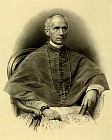
Birth. September 20, 1811, Turin. Son of Andrea Gonella (1770-1851), a banker, originally from Carrù (Mondovi), devoted to the Holy See, ennobled in 1845, and Teresa Maria Gaetana Anselmetti (+ post 1855). Received the sacrament of confirmation, May 22, 1820. His brother Pietro Luigi was a Jesuit priest.
Education. Primary and secondary education at the Jesuit collegio of Turin; after obtaining a title to teach mathematics at the University of Turin, he decided to enter the ecclesiastical state; no longer young, he followed the advice of Archbishop Luigi Fransoni of Turin to privately follow the theological courses at the Congregation of the Virgin Mary's Oblates in Turin; and at the Archgymnasium of Rome, La Sapienza University, where he obtained a doctorate in utroque iure, both canon and civil law, on December 20, 1841.
Priesthood. Ordained, February 18, 1838, Saluzzo. A month later, at the request of some ecclesiastics who appreciated his doctrine and moral qualities, in spite of his timid nature, as well as the determination with which he was able to argue about faith in the attacks of Free Thinkers, and with the support of his father, who was with Cardinal Luigi Lambruschini, then prefect of the S.C. Studies, he moved to Rome to perfect himself in the juridical and theological studies at La Sapienza. Referendary prelate, February 17, 1842. Domestic prelate of His Holiness, 1842. Worked at the S.C. of Extraordinary Ecclesiastical Affairs, 1842. Prelate adjunct of the S.C. of the Tridentine Council, 1843-1845. Protonotary apostolic ad honorem. Consultor of the S.C. of Extraordinary Ecclesiastical Affairs, 1845. Apostolic delegate in the province of Orvieto, January 23, 1846 to 1847; and in the province of Viterbo, June 18, 1847 to 1848. Fled to Gaeta with Pope Pius IX in 1848 after the institution of the Roman Republic.
Episcopate. Elected titular archbishop of Neocesarea, May 20, 1850. Consecrated, May 26, 1850, in the Sistine Chapel, by Pope Pius IX, assisted by Domenico Lucciardi, titular archbishop of Damasco, secretary of the S.C. of Bishops and Regulars, and by Giuseppe Maria Castellani, O.E.S.A., titular bishop of Porfireone, papal sacristan. In the same ceremony was consecrated Cardinal Luigi Vannicelli Casoni, archbishop of Ferrara. Nuncio in Belgium, June 13, 1850. Assistant at the Pontifical Throne, July 23, 1850. Nuncio in Bavaria, October 1 (1), 1861. Transferred to the see of Viterbo and Toscanella (now Tuscania), with the title of archbishop ad personam, June 22, 1866.
Cardinalate. Created cardinal priest in the consistory of March 13, 1868; received the red hat and the title of S. Maria sopra Minerva, March 16, 1868. Visitor to the houses for abandoned children in Viterbo, March 24, 1868. Participated in the First Vatican Council, 1869-1870.
Death. April 15, 1870, Rome. Exposed in the church of S. Agostino, Rome, where the funeral took place with the participation of Pope Pius IX; and buried in the cathedral of Viterbo, according to his will (2).
Bibliography. "Cardinali defunti." La Gerarchia Cattolica e la Famiglia Pontificia per l'anno 1876. Roma : Tipografia dei Fratelli Monaldi, 1875, p. 131-132; De Marchi, Giuseppe. Le nunziature apostoliche dal 1800 al 1956. Pref. di Antonio Samoré. Roma : Edizioni di Storia e letteratura, 1957, pp. 55-56 and 62; Ritzler, Remigium, and Pirminum Sefrin. Hierarchia Catholica Medii et Recentioris Aevi. Volumen VIII (1846-1903). Patavii : Typis et Sumptibus Domus Editorialis "Il Messaggero di S. Antonio" apud Basilicam S. Antonii, 1979, pp. 18, 50, 406 and 593; Weber, Christoph. Kardinäle und Prälaten in den letzten Jahrzehnten des Kirchenstaates : Elite-Rekrutierung, Karriere-Muster u. soziale Zusammensetzung d. kurialen Führungsschicht zur Zeit Pius' IX. (1846-1878). Stuttgart : Hiersemann, 1978. (Päpste und Papsttum; Bd. 13, I-II), II, 471-472 and 681.
Webgraphy. Biography by Carlo M. Fiorentino, in Italian, Dizionario Biografico degli Italiani - Volume 57 (2001), Treccani; his arms, portrait and engraving, Araldica Vaticana.
(1) This is according to Ritzler, Hierarchia Catholica Medii et Recentioris Aevi, VIII, 406; De Marchi, Le nunziature apostoliche dal 1800
al 1956, pp. 55 and 62, says that he was named on September 30, 1861.
(2) This is the text of the inscription on his funeral monument, kindly provided by Mr. Eman Bonnici, from Malta:
MATTHEO . EUSTACHIO . CARD . GONELLA
DOMO . AUGUST . TAURIN
QUI
GREGORIO . XVI . ITEMQ . PIO . IX . PONT . MAX .
VITAE . INTEGRITATE . AC . PRUDENTIA . PROBATUS .
PRAETURA . URBIVENT . ET . VITERB . LEGATIONE . BELGIC
AC . VINDELIC . SANCTE . PERFUNCTUS . ECCLS . VIT .
ET . TUSCAN . PER . AN . FERE . IV . OPTIME . MODERATUS .
SANCTIORIS . DISCIPLINAE . REVOCAN . STUDIO . EFFUSA
IN . PAUPERES . LIBERALIT . CLARISSIMUS . DUM . IN .
URBE . CONCILIO . MAGNO . VATIC . I . ADESSENT . ACERBA
MORTE . INTERCEPTUS . EST . DIE . SANCTO . PARASCEVES
AN . MDCCCLXX . VIX . AN . LVIII . M. III . D. XXVI .
MARCUS . ET . IGNATIUS . EQQ . EX . TESTAM . HEREDES .
FRATRI . OPTIMO . DESIDERATISSIMO
PP .
TE . ☧ IN PACE .

Birth. December 1, 1801, Ancona. Son of Gregorio Barili and Eufrasia Mariotti.
Education. Seminary of Ancona, Ancona; Collegio Capranica, Rome; Collegio Romano, Rome; Seminario Romano, Rome; Pontifical Roman Athenaeum of S. Apollinare, Rome (doctorates in philosophy and theology).
Priesthood. Ordained, September 2, 1827, Ancona, by Cesare Membrini Pironi Gonzaga, bishop of Ancona. Further studies, Rome. In Ancona, 1833-1839, professor of philosophy and prefect of studies at its seminary; prefect of Scuole del Ginnasio; prefect of Biblioteca Comunal; primicerius of its cathedral chapter; secretary of the Congregation of S. Paolo. Auditor of the nunciature in the Kingdom of the Two Sicilies, 1839-1844. Auditor of the nunciature in Portugal, 1844-1848. Internuncio in Brasil, May 13, 1848-1851; before leaving for Brazil was named to a special mission in Switzerland but the Roman revolution of 1848 retained him in Ancona where he was named pro-vicar general of Cardinal Antonio Maria Cadolini, bishop of Ancona, 1848-1849. Domestic prelate of His Holiness. Apostolic delegate in Nueva Granada (Colombia) May 26, 1851; although the diplomatic relations were broken on September 21, 1853, he remained in his post until the end of 1856.
Episcopate. Elected titular archbishop of Tiana, August 3, 1857. Consecrated, November 1, 1857, cathedral of Ancona, by Cardinal Giovanni Brunelli. assisted by Antonio Benedetto Antonucci, bishop of Ancona, and by Giovanni Francesco Magnani, bishop of Recanati e Loreto. Nuncio in Spain, November 13 (1), 1857. Assistant at the Pontifical Throne, January 26, 1858.
Cardinalate. Created cardinal priest in the consistory of March 13, 1868; received the red hat and the title of S. Agnese fuori le mura, September 24, 1868. Participated in the First Vatican Council, 1869-1870. Prefect of the S.C. of Indulgences and Relics, September 6, 1872.
Death. March 8, 1875, Rome, after a long and painful incurable illness. Exposed in the church of S. Agnese in Agone, Rome; the funeral mass was celebrated by Edward Henry Howard of Norfolk, titular archbishop of Neocesarea, vicar of the patriarchal Vatican basilica, March 12, 1875. Buried temporarily, in Campo Verano cemetery, Rome. His body was transferred to Ancona on March 8, 1878.
Bibliography. "Cardinali defunti." La Gerarchia Cattolica e la Famiglia Pontificia per l'anno 1876. Roma : Tipografia dei Fratelli Monaldi, 1875, p. 136; De Marchi, Giuseppe. Le nunziature apostoliche dal 1800 al 1956. Pref. di Antonio Samoré. Roma : Edizioni di Storia e letteratura, 1957, pp. 76, 96 and 237-238; L'Osservatore Romano [electronic resource]. Città del Vaticano : L'Osservatore Romano, XV, n. 56 ( March 10, 1875), p. 2; and XV, n. 58 (March 12, 1875), p. 3; Ritzler, Remigium, and Pirminum Sefrin. Hierarchia Catholica Medii et Recentioris Aevi. Volumen VIII (1846-1903). Patavii : Typis et Sumptibus Domus Editorialis "Il Messaggero di S. Antonio" apud Basilicam S. Antonii, 1979, pp. 18, 46 and 573; Restrepo Posada, José. "Galería de representantes de la Santa Sede en Colombia." Revista de la Academia Colombiana de Historia Eclesiástica , January-June 1970, pp. 193-202; Weber, Christoph. Kardinäle und Prälaten in den letzten Jahrzehnten des Kirchenstaates : Elite-Rekrutierung, Karriere-Muster u. soziale Zusammensetzung d. kurialen Führungsschicht zur Zeit Pius' IX. (1846-1878). Stuttgart : Hiersemann, 1978. (Päpste und Papsttum; Bd. 13, I-II), II, 434-435 and 690.
Webgraphy. His engraving and biography, in French, Wikipédia; his arms, engraving and photography, Araldica Vaticana.
(1) This is according to Ritzler, Hierarchia Catholica Medii et Recentioris Aevi, VIII, 573; De Marchi, Le nunziature apostoliche dal 1800 al 1956, 237, says that he was appointed on October 16, 1857.
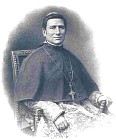
Birth. September 28, 1810, Ceccano, diocese of Ferentino. Son Vincenzo Berardi, a merchant, and Anna Maria Bruni. His brother Filippo (1830-1895) was marquis (1877), deputy (1880) and senator of the Kingdom of Italy (1882). Received the sacrament of confirmation June 20, 1815.
Education. Initial studies in Ceccano; then studied at the Seminary of Ferentino; and later, at Collegio Romano, Rome, where he obtained a doctorate in theology ad honorem); and at Archgymnasium of Rome, La Sapienza University, Rome, where he earned a doctorate in utroque iure, both canon and civil law, on July 4, 1837).
Early life. Having become a lawyer, he became so distinguished in his profession that Cardinals Luigi Lambruschini and Mario Mattei asked him to enter judiciary. Had been married and had a daughter but they died prematurely. As a lay lawyer, judge auditor of second turn at the Apostolic Chamber, 1843-1844. He enter the ecclesiastical state and took the ecclesiastical habit in 1844. Referendary prelate, November 28, 1844. He was a close friend of Cardinal Giacoma Antonelli who helped him progress in his career. Relator of the Sacred Consulta, 1845. Lieutenant of the Criminal Tribunal, 1846. Lieutenant of the Civil Congregation of the Apostolic Chamber and of the vice-president of the Criminal Tribunal, 1847. He was with Pope Pius IX in Gaeta, during the Roman Revolution, 1848-1849. Commissary extraordinary in Marittima e Campagna, 1849. Pro-legate in Velletri, September 1, 1849. Protonotary apostolic participantium, April 30, 1850 to 1863. Vice-president of the Civil Tribunal of Rome, 1851. Substitute of the Secretariat of State and secretary of the Cipher, April 10, 1851 until March 1868. Secretary of the S.C. of Extraordinary Ecclesiastical Affairs, retaining the post of substitute of the Secretariat of State, January 18, 1859; resigned, October 51, 1860. Consultor of the S.C. of the Holy Office, 1861.
Priesthood. Ordained, March 19, 1862, in Rome.
Episcopate. Elected titular archbishop of Nicea, April 7, 1862. Consecrated, November 8, 1863, Gesù Church, Rome, by Cardinal Costantino Patrizi, sub-dean of the Sacred College of Cardinals and secretary of the Supreme S.C. of the Roman and Universal Inquisition, assisted by Alessandro Franchi, titular archbishop of Tessalonica, and by Francesco Marinelli, O.S.A., titular bishop of Porfireone, papal sacristan.
Cardinalate. Created cardinal priest in the consistory of March 13, 1868; received red hat and the title of Ss. Marcellino e Pietro, March 16, 1868. Administrator of commerce, March 23, 1868. Pro-minister of Commerce and Public Labor, April 1868 to 1870. Participated in the First Vatican Council, 1869-1870. Participated in the conclave of 1878, which elected Pope Leo XIII.
Death. April 6, 1878, Rome. Exposed in the church of Gesù, Rome; and buried in Campo Verano cemetery, Rome (1).
Bibliography. "Cardinali defunti." La Gerarchia Cattolica e la Famiglia Pontificia per l'anno 1903, Città del Vaticano : Tipografia poliglotta vaticana, 1903, p. 172; De Marchi, Giuseppe. Le nunziature apostoliche dal 1800 al 1956. Pref. di Antonio Samoré. Roma : Edizioni di Storia e letteratura, 1957, pp. 22 and 31; Ritzler, Remigium, and Pirminum Sefrin. Hierarchia Catholica Medii et Recentioris Aevi. Volumen VIII (1846-1903). Patavii : Typis et Sumptibus Domus Editorialis "Il Messaggero di S. Antonio" apud Basilicam S. Antonii, 1979, pp. 18, 49 and 411; Weber, Christoph. Kardinäle und Prälaten in den letzten Jahrzehnten des Kirchenstaates : Elite-Rekrutierung, Karriere-Muster u. soziale Zusammensetzung d. kurialen Führungsschicht zur Zeit Pius' IX. (1846-1878). Stuttgart : Hiersemann, 1978. (Päpste und Papsttum; Bd. 13, I-II), II, 437-438, 547, 682, 691, 728, 740, 748 and 752.
Webgraphy. Biography by Maria Teresa Tamassia, in Italian, Dizionario Biografico degli Italiani - Volume 8 (1966), Treccani; his arms, engravings and photograph, Araldica Vaticana.
(1) Originally buried at Campo Verano Cemetery, his remains were later moved to the church of Santa Maria in Aquiro in the same city and reburied in the chapel of the Guardian Angel acquired by his brother Filippo, which he also restored. This is the text of his epitaph, kindly provided by Mr. Eman Bonnici, from Malta: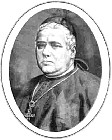
Birth. November 24, 1817, Guatemala. Of a family descendant of Saint Toribio Mogorvejo, archbishop of Lima, Perú. Son of Miguel Moreno y Morán de Butrón (1782-1851), born in Guayaquil, of an illustrious family; and Dolores Maisonave, originally from Cádiz, her father was French. Cousin of Gabriel García Moreno (1821-1875), who was president of Ecuador. The family left Guatemala for Europe in 1823 at the triumph of the independentists, but he always considered Guatemala his motherland. After a brief stay in Scotland, the family went to Spain. The father was deputy to the Cortes of Cádiz; oidor and regent of the Audiencia of Santiago de Guatemala of Guatemala (1814-1821); and later, of the ones of Valencia (1828) and Madrid (1834).
Education. Studied at Breenock, Scotland, 1823; at Puerto de Santa María, Spain, 1825; in Valencia, 1830 (humanities); at the Jesuit Collegio, Madrid, 1834 (philosophy); and at the Central University of Madrid, where he obtained a doctorate in utroque iure, both canon and civil law, on August 7, 1842.
Early life. Professor of law (Notariado) at the Central University, Madrid, from March 1844 to 1849.
Priesthood. Ordained, July 1, 1849. In the archdiocese of Burgos, archdeacon of the metropolitan cathedral, January 4, 1851; provisor and vicar general. Auditor of the Supreme Tribunal of the Roman Rota in the nunciature in Madrid, April 30, 1853.
Episcopate. Elected bishop of Oviedo, September 25, 1857. Consecrated, Tuesday, December 8, 1857, at the church of San Isidro, Madrid, by Cirilo de Alameda y Brea, O.F.M.Conv., archbishop of Toledo, assisted by Antonio María Claret y Clará, C.M.F., archbishop of Santiago de Cuba, future saint, and by Fernando La Puente Primo de Rivera, archbishop of Burgos. Assistant at the Pontifical Throne, January 10, 1862. Promoted to the metropolitan see of Valladolid, October 1, 1863.
Cardinalate. Created cardinal priest in the consistory of March 13, 1868; received red hat and the title of S. Maria della Pace, November 22, 1869. Participated in the First Vatican Council, 1869-1870. Transferred to the primatial and metropolitan see of Toledo, July 5, 1875. Participated in the conclave of 1878, which elected Pope Leo XIII.
Death. August 28, 1884, suddenly, of an apoplexy, in Madrid (1). Exposed and buried in the metropolitan and primatial cathedral of Toledo, in front of the chapel of El Transparente, between the tomb of Cardinal Diego de Astorga y Céespedes and the chapel of San Ildefonso (2).
Bibliography. "Cardinali defunti", La Gerarchia Cattolica e la Famiglia Pontificia per l'anno 1876. Città del Vaticano : Tipografia de la R.C.A., 1902, p. 180; Guitarte Izquierdo, Vidal. Episcopologio Español (1700-1867). Españoles obispos en España, América, Filipinas y otros países. Rome : Instituto Español de Historia Eclesiástica, 1994. (Publicaciones del Instituto Español de Historia Eclesiástica; Subsidia; 29), p. 197; LeBlanc, Jean. Dictionnaire biographique des cardinaux du XIXe siècle : contribution à l'histoire du Sacré Collège sous les pontificats de Pie VII, Léon XII, Pie VIII, Grégoire XVI, Pie IX et Léon XIII, 1800-1903. Montré;al : Wilson & Lafleur, 2007. (Collection Gratianus. Série instruments de recherche), p. 660-662; Martín Tejedor, Jesús. "Moreno y Maisonave, Juan de la Cruz Ignacio." Diccionario de Historia Eclesiástica de España. Dirigido por Quintín Aldea Vaquero, Tomás Marín Martínez, José Vives Gatell. Madrid : Instituto Enrique Flórez, Consejo Superior de Investigaciones Científicas, 1972-1975. 4 vols., and supplement, 1987, II, 1741-1742; L'Osservatore Romano [electronic resource]. Città del Vaticano : L'Osservatore Romano, XXIV, n. 200 (August 30, 1884), p. 3; Ritzler, Remigium, and Pirminum Sefrin. Hierarchia Catholica Medii et Recentioris Aevi. Volumen VIII (1846-1903). Patavii : Typis et Sumptibus Domus Editorialis "Il Messaggero di S. Antonio" apud Basilicam S. Antonii, 1979, pp. 18, 50, 431 and 580.
Webgraphy. Biography by Vicente Cárcel Ortí, in Spanish, Diccionario Biográfico Español, DB~e; his engraving and biography, in Spanish, Wikipedia; his engraving by Marcelo Paris - La Ilustración Española y Americana, Año XXVIII, n.º. 33. de 9 de septiembre de 1884: 129; his arms and engraving, Araldica Vaticana.
(1) This is according to Ritzler, Hierarchia Catholica Medii et Recentioris Aevi, VIII, 18; and LeBlanc, Dictionnaire biographique des
cardinaux du XIXe siècle, p. 661. La Gerarchia Cattolica e la Famiglia Pontificia, p. 180, indicates that he died in Toledo.
(2) This is the text of the inscription on his tomb, kindly provided by Mr. Mark West, from London:
HIC EXPECTAT
EMMUS AC RMUS D. DR.
JOANN. YGNATIUS
PRESB. CARD. MORENO
EX OVET AC VALISOLET
CATHEDRA
AD HANC PRIM HISPAN
ASSUMPTUS
OB. MATR: V KAL. SEPT.
MDCCCLXXXIV
ORATE PRO EO
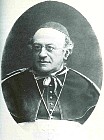
Birth. February 23, 1827, Aquila. Of a bourgeois family originally from Chieti. Third of the five children of Domenico Monaco la Valetta, who died when his children were young, and Maria Maddalena De Felici-Umani. The mother then moved with them to Chieti. The other siblings were Gaspare (1819-1881), who was senator of the kingdom of Italy (1864), Concetta, Maria and Francesco. The second surname was added by his father, who descended from a La Valletta that was grand master of the Sovereign Military Order of Malta.
Education. When he was eight years old, he was sent to study at Collegio del Salvatore in Naples, where he was for two years, because at the unexpected death of his father, the mother, left alone with the five dependent children, decided to return to the De Felice Umani palace, adjacent to the church of SS. Trinità in Chieti with her children; then, he frequented Real Collegio Teatino of the Scolapini fathers, in Chieti, where he remained until he was seventeen years old; then, he studied at the school and Seminary of Aquila; later, at Collegio Romano, Rome; at the Pontifical Gregorian University, Rome, where he obtained doctorates in philosophy and theology; at La Sapienza University, Rome, where he earned a doctorate in utroque iure, both canon and civil law; and at the Pontifical Academy of Ecclesiastical Nobles, Rome, from 1846, where he studied diplomacy.
Priesthood. Ordained, September 22, 1849, in Gaeta, by Pope Pius IX. Referendary prelate, December 14, 1854. Prelate adjunct of the S.C. of the Tridentine Council, 1857-1868. Protonotary apostolic supernumerary, 1858. Pro-assessor of the S.C. of the Holy Roman and Universal Inquisition, January 25, 1859; assessor, December 20, 1859 to 1868. Canon of the chapter of the patriarchal Vatican basilica, 1859.
Cardinalate. Created cardinal priest in the consistory of March 13, 1868; received red hat and the title of S. Croce in Gerusalemme, March 16, 1868. Participated in the First Vatican Council, 1869-1870. Secretary of Petitions and Memorials, November 2, 1870. Abbot commendatario of Ss. Benedict and Scholastica of Subiaco, March 20, 1873 until November 1884. He was bailif grand cross of honor and devotion of the Sovereign Military Order of Malta.
Episcopate. Elected titular archbishop of Eraclea, January 9, 1874. Consecrated, January 12, 1874, Hall of the Consistory, in the Vatican, Rome, by Pope Pius IX, assisted by Frédéric-François-Xavier Ghislain de Mèrode, titular archbishop of Melitene, private almoner of His Holiness, and by Francesco Marinelli, titular bishop of Porfireone, papal sacristan. Vicar of His Holiness for the City of Rome, December 21, 1876. Prefect of the S.C. of the Residence of Bishops from December 21, 1876 until February 15, 1884. Participated in the conclave of 1878, which elected Pope Leo XIII. Camerlengo of the Sacred College of Cardinals, February 27, 1880 until May 13, 1881. Grand penitentiary, February 12, 1884 until his death. Secretary of the Supreme S.C. of the Universal and Roman Inquisition, February 15, 1884 until his death. Opted for the order of cardinal bishops and the suburbicarian see of Albano, March 24, 1884. Archpriest of the patriarchal Lateran Basilica, March 4, 1885. Administrator of the suburbicarian diocese of Frascati during the illness of Cardinal Edward Henry Howard, March 24, 1888. Prefect of the S.C. Ceremonial, March 1, 1889. Opted for the suburbicarian see of Ostia e Velletri, May 24, 1889. Dean of the Sacred College of Cardinals. Grand prior commendatario in Rome of the Sovereign Military Order of St. John of Jerusalem, June 18, 1894.
Death. July 14, 1896, Agerola, archdiocese of Amalfi. Exposed in the church of S. Lazzaro, Agerola. Buried in Torre dei Cappuccini, tomb of the Capuchin Friars in Campo Verano Cemetery, Rome (1). On July 21, 1896, a solemn funeral was celebrated in the church of S. Andrea della Valle, Rome.
Bibliography. "Cardinali defunti." La Gerarchia Cattolica e la Famiglia Pontificia per l'anno 1903, Città del Vaticano : Tipografia poliglotta vaticana, 1903, p. 199; Ritzler, Remigium, and Pirminum Sefrin. Hierarchia Catholica Medii et Recentioris Aevi. Volumen VIII (1846-1903). Patavii : Typis et Sumptibus Domus Editorialis "Il Messaggero di S. Antonio" apud Basilicam S. Antonii, 1979, pp. 18, 43, 44 and 48; Weber, Christoph. Kardinäle und Prälaten in den letzten Jahrzehnten des Kirchenstaates : Elite-Rekrutierung, Karriere-Muster u. soziale Zusammensetzung d. kurialen Führungsschicht zur Zeit Pius' IX. (1846-1878). Stuttgart : Hiersemann, 1978. (Päpste und Papsttum; Bd. 13, I-II), II, 488, 691, 729, 740, 748 and 752.
Webgraphy. Biography by Carlo M. Fiorentino, in Italian, Dizionario Biografico degli Italiani - Volume 75 (2011), Treccani; his photograph and biography, in Italian, Wikipedia; his engravings, arms, photographs and portraits, Araldica Vaticana; Cronotassi dei Cardinali Penitenziari Maggiori, in Italian, Penitenziaria Apostolica.
(1) This is the text of the inscription on his vault, kindly provided by Mr. Eman Bonnici, from Malta:
EPUS HOSTIENSIS ET VELITERNUS
SACRI COLLEGII DECANUS
POENITENTIARIUS MAJOR
DOCTRINA PIETATE PRUDENTIA
RERUM GERENDARUM PERITIA
AC EFFUSA IN PAUPERES LIBERALITATE COMMENDATUS
QUIESCIT IN TUMULO A TERGO HUJUS SACELLI
IN CONDITORIO FRATRUM CAPULATORUM
QUO INFERRI VOLUIT
CUM ILLOS PATRONUS MIRE DILEXISSET
---------------
NATUS AQUILAE IN VESTINIS
OBIIT SEPTUAGENARIUS PROPE NEAPOLIM
PRID. ID. AUG. A. MDCCCLXXXXVI
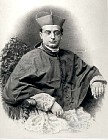
Birth. August 3, 1822, Milan. Son of Count Vitaliano Borromeo (1792-1874), ninth marquis of Anghera (1837), senator of the Kingdom of Italy (1853), and Maria d’Adda (1796-1862). He was baptized on that same day in the parish of S. Alessandro and received the names Edoardo Lodovico Carlo Renato Giovanni Benedetto; his uncle, Count Renato Borromeo, was the godfather. His last name is also listed as Borromeo Arese. Great-grand-nephew of Cardinal Vitaliano Borromeo (1766). Other cardinals of the family were Carlo Borromeo (1560); Federico Borromeo, seniore (1587); Giberto Borromeo, seniore (1652); Federico Borromeo, iuniore (1670); and Giberto Bartolomeo Borromeo (1717).
Education. Studied at Collegio Romano, Rome, where he earned a doctorate in philosophy in 1841; and at the Pontifical Academy of Ecclesiastical Nobles, Rome, from 1840, where he obtained a doctorate in utroque iure, both canon and civil law, on July 27, 1842); studied theology in Rome with autorizzazione sovrana.
Early life. In May 1838, along with his brother Emmanuele, served as a page during the stay of the emperor of Austria in Milan. Received the minor orders in 1841. In 1843, he wanted to take religious vows but his parents dissuaded him. Declared Accademico Eclesiastico, January 12, 1844. Named socio corrispondente of Accademia degli Inteleti di San Miniato, September 12, 1844. Privy chamberlain participant of His Holiness, April 24, 1845 to 1850.
Priesthood. Ordained, December 1846, Rome, by Pope Pius IX. Canon of the patriarchal Vatican basilica, 1847. Remained at the side of the pope during the revolution of 1848 and accompanied him to Gaeta. Named by the king of the Belginas commendatore of the Order of Leopold II, September 21, 1855. Master of Admissions of His Holiness, March 31, 1850 to 1856. During the cholera epidemic in Rome, 1855-1856, zealously assisted the victims, especially their orphan children. Prefect of the Pontifical House, June 20, 1856.
Cardinalate. Created cardinal deacon in the consistory of March 13, 1868; received red hat and the deaconry of Ss. Vito e Modesto, March 16, 1868. Prefect of the Apostolic Palace, January 28, 1869. Participated in the First Vatican Council, 1869-1870. Archpriest of the patriarchal Vatican basilica and prefect of the S.C. of the Fabric of St. Peter, July 10, 1872. Participated in the conclave of 1878, which elected Pope Leo XIII. Opted for the order of cardinal priests and the title of S. Prassede, March 28, 1878.
Episcopate. Elected titular archbishop of Adana, April 19, 1878. Consecrated, May 19, 1878, Sistine Chapel, the Vatican, by Pope Leo XIII, assisted by Alessandro Sanminiatelli Zabarella, titular archbishop of Tiana, grand almoner of His Holiness, and by Francesco Marinelli, O.S.A., titular bishop of Porfireone, papal sacristan. Camerlengo of the Sacred College of Cardinals, February 28, 1879 until February 27, 1880.
Death. November 30, 1881, at 2:30 p.m., Rome. Exposed in the church of Ss. Ambrogio e Carlo dei Lombardi, Rome, and buried in a temporary tomb, in Campo Verano cemetery, Rome. Transferred to the new chapel of the Vatican chapter in Campo Verano cemetery, October 25, 1883.
Bibliography. "Cardinali defunti." La Gerarchia Cattolica e la Famiglia Pontificia per l'anno 1903, Città del Vaticano : Tipografia poliglotta vaticana, 1903, p. 176; Furlani, Silvio. "Borromeo, Edoardo." Enciclopedia Cattolica, 12 vols. Città del Vaticano: Ente per l'Enciclopedia Cattolica e per il Libro Cattolico, 1949-1954, vol. II, col. 1927; Ritzler, Remigium, and Pirminum Sefrin. Hierarchia Catholica Medii et Recentioris Aevi. Volumen VIII (1846-1903). Patavii : Typis et Sumptibus Domus Editorialis "Il Messaggero di S. Antonio" apud Basilicam S. Antonii, 1979, pp. 18, 52, 55, 63 and 74; Weber, Christoph. Kardinäle und Prälaten in den letzten Jahrzehnten des Kirchenstaates : Elite-Rekrutierung, Karriere-Muster u. soziale Zusammensetzung d. kurialen Führungsschicht zur Zeit Pius' IX. (1846-1878). Stuttgart : Hiersemann, 1978. (Päpste und Papsttum; Bd. 13, I-II), II, 442-443, 548, 671, 681, 692, 719, 741, 748 and 754.
Webgraphy. His engraving and biography, in Italian, Wikipedia; his portrait, Centro culturale Gli scritti; his photograph, engraving and arms, Araldica Vaticana.
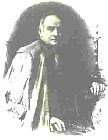
Birth. January 21, 1811 (1), Rome. Second child of Lorenzo Capalti, a businessman and banker (associated with the Sculteis Bank), originally from Civitavecchia, where he was mayor, and Anna Serafini, a painter. Brother of the painter Alessandro Capalti (1807-1868).
Education. Seminary of Volterra, Volterra; Seminario Romano, Rome (doctorate in philosophy and theology).
Priesthood. Ordained (no further information found). Administrator of the Society degli asili d'Infanzia, Rome. Coadjutor, with future succession, of Msgr. Brunelli, professor ordinary of canonical texts at La Sapienza University, Rome, 1839; professor ordinary, 1840-1847. Canon of the chapter of S. Maria in Trastevere, Rome. Secretary of the S.C. of Studies, November 1845 to March 1852. Canon of the patriarchal Lateran basilica. Prefect of studies of Seminario Romano, 1848-1860. Sostituto of the minister of Public Instruction, 1848. Consultor of the S.C. of Extraordinary Ecclesiastical Affairs and of the S.C. of the Index, 1851. Member of the Council of State, 1851-1860. Secretary of the S.C. of Rites, November 14, 1854 to 1861. Secretary of the S.C. of Propaganda Fide, March 30, 1861 to 1868.
Cardinalate. Created cardinal deacon in the consistory of March 13, 1868; received red hat and the deaconry of S. Maria in Aquiro, March 16, 1868. Participated in the First Vatican Council, 1869-1870. Prefect of the S.C. of Studies from January 3, 1870 until his death.
Death. October 18, 1877, Rome. Buried in Campo Verano cemetery, Rome.
Bibliography. Ritzler, Remigium, and Pirminum Sefrin. Hierarchia Catholica Medii et Recentioris Aevi. Volumen VIII (1846-1903). Patavii : Typis et Sumptibus Domus Editorialis "Il Messaggero di S. Antonio" apud Basilicam S. Antonii, 1979, pp. 18 and 54; Weber, Christoph. Kardinäle und Prälaten in den letzten Jahrzehnten des Kirchenstaates : Elite-Rekrutierung, Karriere-Muster u. soziale Zusammensetzung d. kurialen Führungsschicht zur Zeit Pius' IX. (1846-1878). Stuttgart : Hiersemann, 1978. (Päpste und Papsttum; Bd. 13, I-II), II, 447-448, 693 and 719.
Webgrapgy. His engraving and biography by Eman Bonnici, in English, Finde a Grave; his photograph, anegraving and arms, Araldica Vaticana.
(1) This is according to Ritzler, Hierarchia Catholica Medii et Recentioris Aevi, VIII, 18, n. 1; Weber, Kardinäle und Prälaten in den letzten Jahrzehnten des Kirchenstaates, II, 447, says that he was born on January 21, 1818; but the same source, II, 691, Dokument 8, cites a report of Anton Freiherr von Cetto about the living cardinals, dated September 14-October 8, 1873, which indicates that Cardinal Capalti was 62 at that time; and on II, 719, Dokument 9, a report by Mons. T. Bellà, dated October 1875, says that Cardinal Capalti was 60.
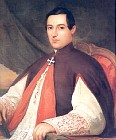
Birth. February 26, 1811, Spoleto. Of a patrician family. His parents were Antonio Pila, regent of Spoleto during the French occupation of the city, and Augusta Maria Carocci.
Education. Seminary of Rieti, Rieti; Collegio de Spello, Spello; La Sapienza University, Rome, from 1832 (obtained a doctorate in utroque iure, both canon and civil law); studio of lawyers Pietro Brenda, Antonio Galiberti, voter of the Tribunal of the Apostolic Signature, and Luigi Bartoli (judicial practice). Received the ecclesiastical tonsure from Cardinal Carlo Odescalchi, August 7, 1837.
Early life. Entered the Roman prelature as referendary on August 17, 1837 under the protection of Cardinal Antondomenico Galimberti, secretary of State for internal affairs; the cardinal successively appointed him voter of first turn of the tribunal of the Congregation of Loreto, December 4, 1837, and relator of the S.C. of Good Government, February 24, 1838; delegate in Camerino before April 28, 1839; in Ascoli, February 18, 1839; and in Frosinone, January 27, 1843. Named protonotary apostolic non patricipantium before March 16, 1839. Recalled to Rome and named voter of the tribunal of the Apostolic Signature in April 1848. Named commissary extraordinary of the provinces of Viterbo, Orvieto and Civitavecchia on August 12, 1849. Cleric of the Apostolic Chamber before January 2, 1851. Member of the Cosulta of State for financial affairs before October 23, 1852. Named by Pope Pius IX minister of the interior on March 18, 1858; he was discharged of his functions seven years later to be named auditor general of the Apostolic Chamber on October 20, 1865. Honorary member of the Roman Academy of Archeology, April 14, 1859. He was inscribed in the patriciate of the cities of Alatri, Angani, Camerino, Ascoli, Montalto and Ripatransone. He published several official documents such as Relazione a Sua Santità sulla istituzione delle Casse di risparmio nello Stato Pontificio e sul loro progresso al 31 dicembre 1857 (Rome, 1859); Sulle spese del cassermaggio delle truppe estere del quadriennio dal 1854 al 1857, liquidate dalla commissione appositamente convocata in Roma. Relazione (Rome, 1859); Sulle spese del cassermaggio delle truppe estere del sessennio dal 1858 al 1863, liquidate dalla commissione appositamente convocata in Roma. Relazione (Rome, 1865).
Sacred orders. (No information found).
Cardinalate. According to Boutry, Souverain et pontife, p. 617, he died à la veille d'acceder au cardinalat, the day before acceding to the cardinalate.
Death. April 23, 1868, Rome. After the funeral in the church of S. Eustachio, he was buried in the church of S. Andrea della Valle, Rome, next to the Vidoni palace, where he resided.
Bibliography. Boutry, Philippe. Souverain et Pontife : recherches prosopographiques sur la curie romaine à l'âge de la restauration, 1814-1846. Rome : École française de Rome, 2002, p. 617-618.
Birth. August 13, 1812, Olivar, former province of Colchagua, presently Libertador General Bernardo O'Higgins Region, Chile. Son of Juan José Salas Olguín and Manuela Toro. With his father playing an active part in the Bando Patriota during the War of Independence, the family had to flee to Peumo after their house was attacked by royalists during the Battle of Rancagua in October 1814. There they remained until the patriotic victory of the Battle of Maipú in 1818.
Education. Received his initial education in a private school opened by his father in Olivar; in 1831, he moved to Santiago, where he furthered his studies in the Convent of San Agustín; and later at the University of San Felipe, earning a bachelor's degree in theology. He recived the tonsure and minor orders in 1833; two years later, he received the subdiaconate and the diaconate.
Priesthood. Ordained, November 22, 1835, by Manuel Vicuña Larraín, bishop of Santiago de Chile. The following year he was appointed professor at the Seminary of Santiago, assuming the chairs of Latin and philosophy. Appointed professor of religion at the National Institute in 1843; that same year he assumed, together with Joaquín Larraín Gandarillas, future auxiliary bishop of Santiago, the running of the then newly born Revista Católica, created by the Archbishop of Santiago, Rafael Valentín Valdivieso, to whom he started serving as private secretary as of 1845. Professor at the now defunct Faculty of Theology at the University of Chile, of which he became dean in 1852; in such capacity he presented on October 29, 1848 the report El servicio personal de los indígenas y su abolición in which he adressed the historical stages that led to the abolition of the encomienda in Chile, a Spanish labor system that rewarded conquerors with the labor of particular groups of conquered non-Christian people. The report treated most favorably by the indigenous but was highly criticized from the conqueror’s side. Such work is considered to be the first investigation in the history of the law to be ever held Chile.
Episcopate. Elected bishop of Santísima Concepción, June 23 1854. Consecrated, October 29, 1854, by Rafael Valentín Valdivieso y Zañartu, archbishop of Santiago de Chile, assisted by Justo Donoso Vivanco, bishop of La Serena, and by Antoine-Magloire Doumer SS.CC., titular bishop of Iuliopoli, coadjutor apostolic vicar of Tahiti. Ordering the reopening of the Seminary of Concepción in 1855, he oversaw the reconstruction of the Cathedral of Concepción in 1867 after the destruction of the previous edifice in the earthquake of 1835. In 1843, he was a candidate in the parliamentary elections of Chile.
Cardinalate. While he was participating in the First Vatican Council, convoked by Pope Pius IX, as part of the Chilean group led by Archbishop Rafael Valentín Valdivieso, during his stay in Rome, the pope offered him the red hat, inviting him to join the Roman Curia, but preferring to spend his last years in Chile, he declined the offer, and the pope did not insist on his intention again.
Death. July 20, 1883, in Concepción, of a stroke after suffering several pulmonary congestions. Buried in the crypt of the cathedral of Concepción under the Capilla del Santísimo.
Bibliography. In an article written by Adolfo Etchegaray Cruz entitled "Mons. José Hipólito Salas en el Concilio Vaticano I" featured in the
Historia review of 1962/63, pp. 134-167, he stated: “Por esos días había circulado un rumor en el lejano Chile: ¡Mons. Rafael Valentin Valdivieso Zañartu, arzobispo
de Santiago, recibiría el capelo cardenalicio! Mons. Valdivieso se impuso de esta noticia por la prensa santiaguina que recibía en Roma. Se apresuró a desmentir ‘por parecerle tal
noticia completamente inmotivada’. El rumor tuvo quizás origen en una equivocación de nombres, pero en todo caso se trata de promover a un chileno a esa dignidad” (p. 158). In fact,
in his book El illmo. sr. dn. José Hipólito Salas, obispo de Concepción, 1812-1883 (Santiago de Chile, Imprenta Cervantes, 1921), Domingo Benigno Cruz, citing
Monseñor Ramón Angel Jara, states in pp. 305-306: “[Jara] comunica al autor que escuchó de labios de Mons. Casanova en los funerales del obispo de Concepción” that “La humildad del
enérgico Obispo de Concepción era tan honda que jamás permitió a su confidente Mons. Mariano Casanova el comunicar que el Papa Pío IX, en vista de los discursos pronunciados durante
el Concilio, le había ofrecido nada menos que la púrpura cardenalicia para consagrarlo al servicio de la Iglesia en la Curia de Roma!”
In Juan Pablo Ríos Araya’s thesis "El juramento civil de los obispos en el pensamiento de José Hipólito Salas", presented to the Universidad de Chile in 2012 furthermore we read:
“En este Concilio, vemos que los temas de los cuales trata José Hipólito Salas pues se proclama el dogma de la Infalibilidad del Papa declarada en la bula Pastor Aeternus. El
Papa se percató de la gran actuación de Salas en el Concilio y, en vista de ello, el Santo Padre le consulta si está dispuesto a ser cardenal de la Curia Romana. Salas no acepta
dicho nombramiento y el Papa no le vuelve a insistir en su intención. De ahí, Salas emprende regreso a Chile en agosto de 1870” (p. 8).
| Top | Consistories | Catalogs | Home |
©1998-2021 Salvador Miranda.